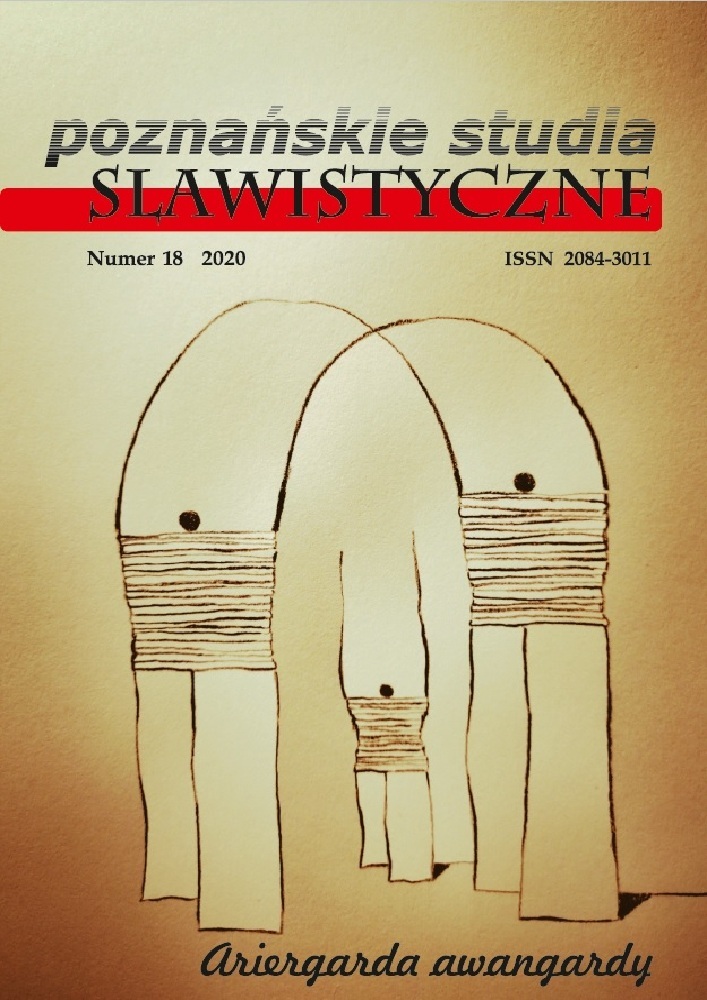Abstrakt
The article presents the selected aspects of the Bulgarian avant-garde movement called “Native Art” (Rodno izkustvo) which developed in art (painting of Ivan Milev and others) and literature (the so-called decorative prose, ars decorum) in the 1920s. An aesthetical object of the then creators was searching for spirituality of the community expressed through a synthesis of such form of cultural heritage as symbolism, secession, Old Bulgarian and Byzantine iconography, rituals and folklore embroideries, ancient mosaic. For the constitution of the style “Rodno izkustvo”, the aesthetics of Bulgarian expressionism along with its artistic forms of rhythm and motion had a special significance. The analysis focuses on the theoretical writings by the most important representatives of Bulgarian avant-garde, namely, Čavdar Mutafov, Geo Milev, Nikolai Rainov, Sirak Skitnik and others whose attitude towards the problems of the style highlighted the process of it arising from individual acts to artistic syntheses. In the article, there are also references to the works of the contemporary art historian Dimitâr Avramov. The interdisciplinary research perspective of the article allows the author to indicate the distinctive properties of the avant-garde style of the Native Art, but also to illuminate the intellectual turn in Bulgarian art at the beginning of the 20th century.
Bibliografia
Avramov, D. (1993). Dviženieto „Rodno izkustvo” – estetika i perspektivi. V: Dialog meždu dve izkustva. Sofia: Bâlgarski pisatel, s. 78–110.
Avramov, D. (1969). Estetika na modernoto izkustvo. Sofia: Bâlgarski pisatel.
Avramov, D. (2013). Prikaznata nostalgija na Ivan Milev. „Literaturen vestnik” nr 8, s. 12–13.
Gigova, R. (2004). Hudožnikât Ivan Pejkov i „Rodno izkustvo” – živopis-tvorčestvo ot vtorata polovina na 20-te godini na XX vek. „Pametnici, restavracii, muzei” nr 2, s. 42–51.
Gâlâbov, K. (1926). Na velika srjada. „Iztok” I, nr 29, s. 1–2.
Gâlâbov, K. (1929). Sâština izadaci na literaturnata kritika. (V pamet na dr K. Krâstev). „Filosofski pregled”, nr 2, s. 191–203.
Krâstev, K. (2019). Spomeni za kulturnija život meždu dvete svetovni vojni. Novo dopâlneno izdanie. Sofia: Era.
Milev, G. (1920). Rodno izkustvo. „Vezni” II, nr 1, s. 40–50. Mutafov, Č. (1921–1922). Zelenijat kon. „Vezni” II, nr 1, s. 129–130.
Mutafov. Č. (1926). Dvojakost na formata v izobrazitelnoto izkustvo. „Iztok” I, s. 4.
Mutafov, Č. (1993). Dvojstvenost v izkustvoto. V: Izbrano. Red. K. Krâstev, Sofia: Gal-Iko, s. 335.
Mutafov, Č. (1993). Dekorativni očertanija v našata živopis. V: Izbrano. Red. K. Krâstev. Sofija: Gal-Iko, s. 339–340.
Radoslavov, Iv. (1922). Po vâprosa okolo ekspresionizma i okolo nego. Stil i stilizacija. „Hiperion” nr 6–7, s. 417–423.
Rajnov, N. (1919). Izkustvo i stil. „Vezni” I, nr 3, s. 69–71.
Rajnov, N. (1921). Živopisen i dekorativen stil v razkaza. „Zlatorog” II, nr 1–2, s. 78–90.
Savov, B. (1924). Skitsko i slavjansko v bâlgarskata literatura. „Hiperion” III, nr 4–5, s. 238–258.
Simeonova-Konach, G. (2011). Postmodernizmât. Bâlgarskijat slučaj. Nabljudenija vârhu hudožestvenata proza na XX i XXI vek. Sofija: Iztok–Zapad.
Skitnik, S. (1923). Tajnata na primitiva. „Zlatorog” IV, br 1, s. 3–6.
Skitnik, S. (1928). Videnijata na Ivan Milev. „Zlatorog” IX, br 5, s. 250–252.
Skitnik, S. (1981). Staro i novo. V: Izbrani statii (1923–1943). Red. K. Krâstev. Sofija: Bâlgarski hudožnik, s. 33–35. Sirak, Skitnik i bâlgarskata kultura. Red. Cv. Rakovski. Blagoevgrad: UI „Neofit Rilski”. Sugarev, Edv. Dimitrova, El.
Atanasova, Cv. (2009). Kritičeskoto nasledstvo na bâlgarskija modernizâm. T. I–III. Sofija: BAN, IC „Bojan Penev”.
Todorov, Tzv. (1999). Semiotika, retorika, stilistika. Sofija: SEMA RS].
Bürger, P. (1974 ). Theorie der Avantgarde. Frankfurt am Main: Suhrkamp 1974, s. 79– –90.
Gałązka, W. (1979). Prymityw i jego funkcja w poezji bułgarskiej okresu międzywojennego. W: Literatury słowiańskie w okresie awangardowego przełomu. Red. Z. Niedziela. Wrocław: Zakład Narodowy im. Ossolińskich, s. 7–33.
Daieva-Schneider, S. (2001). Čavdar Mutafov und der deutsche Expressionismus. Eine interkulturelle Studie zur Rolle des deutschen literarischen und künstlerischen Expressionismus im Werk eines bulgarischen Schriftstellers und Kunsttheoretikers. Frankfurt am Main [u.a.]: Peter Lang.
Kluszczyński, R.W. (1997). Awangarda – rozważania teoretyczne. Łódź: Wydawnictwo Uniwersytetu Łódzkiego.
Ortega y Gasset, H. (1980). Dehumanizacja sztuki. W: H. Ortega y Gasset. Dehumanizacja sztuki i inne eseje. Wyb. i wstęp S. Cichowicz. Przeł. P. Niklewicz. Warszawa: Czytelnik, s. 278–323.
Savov, B. (1985). Element scytyjski i słowiański w literaturze bułgarskiej. W: Naród i kultura. Antologia esejów i artykułów o narodzie i kulturze bułgarskiej. Red. W. Gałązka. Kraków: Wydawnictwo UJ, s. 107–113.
Licencja
Prawa autorskie (c) 2020 Galia Simeonova-Konach

Utwór dostępny jest na licencji Creative Commons Uznanie autorstwa – Bez utworów zależnych 4.0 Międzynarodowe.

